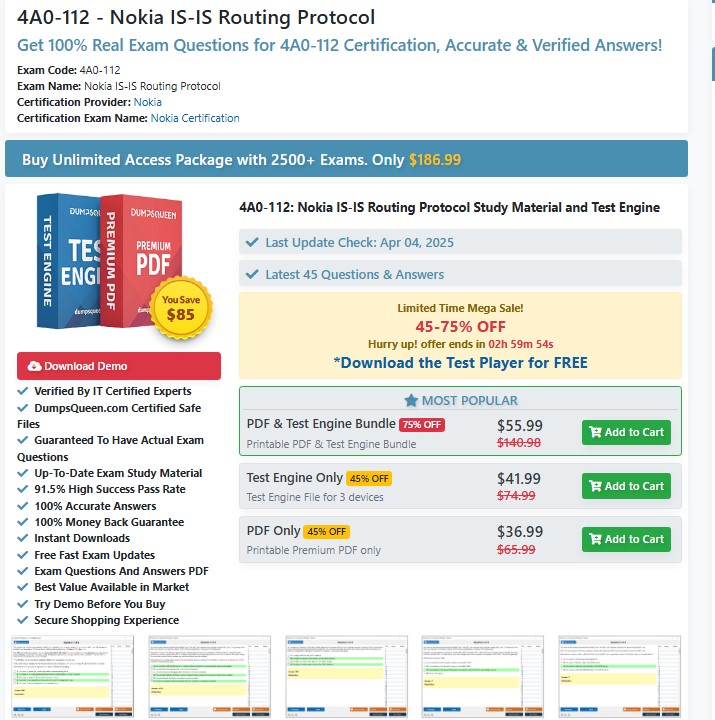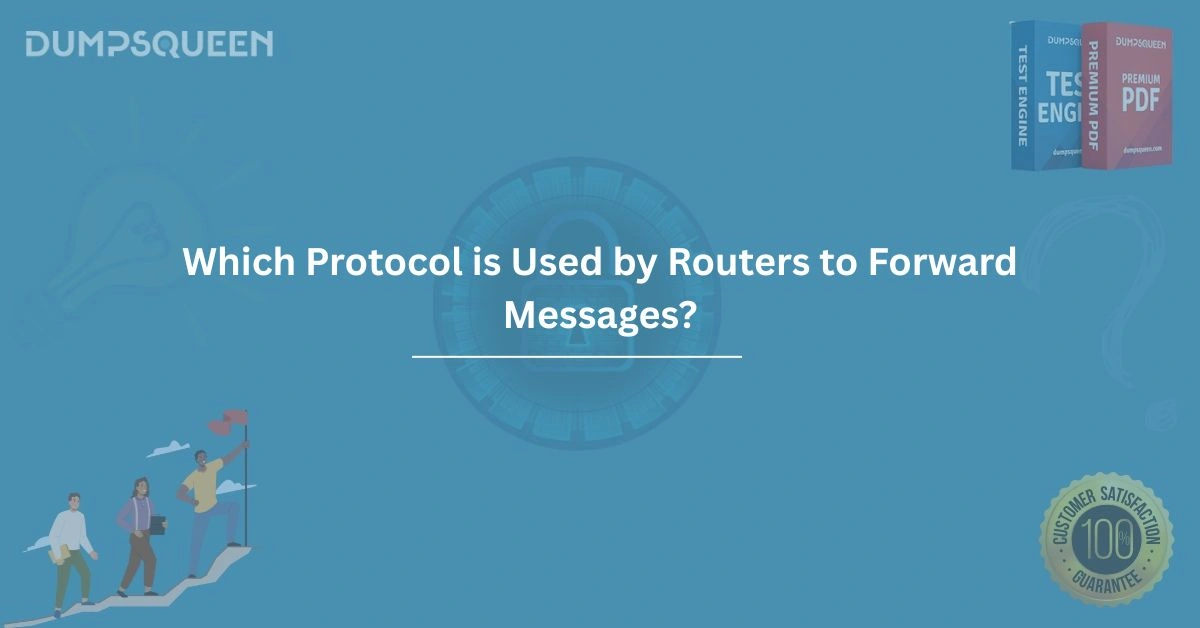Introduction
In the intricate world of networking, routers serve as the backbone of data communication, directing traffic across networks to ensure seamless connectivity. A fundamental question for anyone delving into networking is: which protocol is used by routers to forward messages? Understanding the protocols that govern this process is essential for network administrators, IT professionals, and students preparing for certifications like Cisco CCNA or CompTIA Network+. At DumpsQueen, we provide comprehensive resources to help you master these concepts and excel in your networking journey. This blog explores the protocols routers use to forward messages, their mechanisms, and their significance in modern networking.
The Role of Routers in Networking
Routers are specialized devices that operate at the network layer (Layer 3) of the OSI model. Their primary function is to forward data packets between networks, determining the most efficient path for data to travel from the source to the destination. Unlike switches, which operate at the data link layer (Layer 2) and forward frames within a single network, routers connect multiple networks, such as those in homes, offices, or across the internet.
To perform this task, routers rely on routing protocols and forwarding mechanisms. These protocols enable routers to exchange information, build routing tables, and make informed decisions about where to send packets. At DumpsQueen, our study materials break down these complex processes into digestible concepts, ensuring you grasp the fundamentals of routing.
Understanding Routing Protocols
Routing protocols are the rules and algorithms that routers use to communicate with one another and share information about network topology. These protocols help routers construct and maintain routing tables, which act as maps for forwarding packets. Routing protocols can be broadly classified into two categories: Interior Gateway Protocols (IGPs) and Exterior Gateway Protocols (EGPs).
IGPs are used within a single autonomous system (AS), such as a company’s internal network. Examples include RIP (Routing Information Protocol), OSPF (Open Shortest Path First), and EIGRP (Enhanced Interior Gateway Routing Protocol). EGPs, on the other hand, are used to exchange routing information between different autonomous systems, with BGP (Border Gateway Protocol) being the most prominent example. Each protocol has unique characteristics, making it suitable for specific network environments.
At DumpsQueen, we offer detailed guides and practice questions on routing protocols to help you prepare for certification exams and real-world networking challenges.
The Packet Forwarding Process
Before diving into specific protocols, it’s crucial to understand how routers forward messages. When a router receives a packet, it examines the destination IP address in the packet’s header. Using its routing table, the router determines the next hop—either another router or the final destination. This process, known as packet forwarding, relies on the information provided by routing protocols.
Packet forwarding involves several steps:
-
Decapsulation: The router strips the Layer 2 frame to access the Layer 3 packet.
-
Routing Table Lookup: The router compares the destination IP address against its routing table to find the best match.
-
Next-Hop Determination: The router identifies the next device in the path, which could be another router or the destination host.
-
Encapsulation and Transmission: The packet is encapsulated into a new Layer 2 frame and sent to the next hop.
This process is repeated at each router until the packet reaches its destination. The efficiency of packet forwarding depends on the accuracy of the routing table, which is maintained by routing protocols.
Key Routing Protocols for Packet Forwarding
Several routing protocols enable routers to forward messages effectively. Below, we explore the most widely used protocols and their roles in networking.
Routing Information Protocol (RIP)
RIP is one of the oldest and simplest routing protocols, designed for small to medium-sized networks. It uses a distance-vector algorithm, where routers share their entire routing table with neighboring routers at regular intervals. RIP calculates the best path based on hop count, with a maximum of 15 hops, making it unsuitable for large networks.
Despite its simplicity, RIP is still used in some legacy systems. However, its limitations, such as slow convergence and lack of support for variable-length subnet masking (VLSM), have led to the adoption of more advanced protocols. At DumpsQueen, our RIP-focused study resources help you understand its mechanics and prepare for exam questions on this protocol.
Open Shortest Path First (OSPF)
OSPF is a link-state routing protocol widely used in large enterprise networks. Unlike RIP, OSPF maintains a detailed map of the network topology, allowing routers to calculate the shortest path to a destination using Dijkstra’s algorithm. OSPF supports hierarchical network design, dividing networks into areas to improve scalability and reduce routing overhead.
OSPF’s fast convergence and support for VLSM make it a preferred choice for modern networks. It also provides robust security features, such as authentication, to prevent unauthorized routing updates. DumpsQueen’s OSPF study guides offer in-depth explanations and practice scenarios to help you master this protocol.
Enhanced Interior Gateway Routing Protocol (EIGRP)
EIGRP, developed by Cisco, is an advanced distance-vector protocol that combines the benefits of distance-vector and link-state protocols. It uses the Diffusing Update Algorithm (DUAL) to calculate the shortest path and ensure loop-free routing. EIGRP supports rapid convergence, load balancing, and scalability, making it ideal for enterprise networks.
One of EIGRP’s standout features is its ability to form neighbor relationships and exchange routing updates only when necessary, reducing bandwidth usage. At DumpsQueen, we provide EIGRP-specific resources to help you understand its configuration and troubleshoot common issues.
Border Gateway Protocol (BGP)
BGP is the protocol that powers the internet, facilitating routing between autonomous systems. Unlike IGPs, BGP is an external gateway protocol that prioritizes policy-based routing over shortest-path calculations. It uses attributes like AS path, next hop, and local preference to make routing decisions.
BGP’s scalability and flexibility make it essential for internet service providers (ISPs) and large organizations. However, its complexity requires a deep understanding of routing policies and configurations. DumpsQueen’s BGP study materials simplify these concepts, helping you prepare for advanced networking certifications.
The Role of IP in Packet Forwarding
While routing protocols build the routing table, the actual forwarding of messages relies on the Internet Protocol (IP). IP, specifically IPv4 and IPv6, provides the addressing scheme that routers use to identify source and destination devices. When a router receives a packet, it uses the IP header to determine the next hop.
IPv4, with its 32-bit address space, has been the dominant protocol for decades. However, the exhaustion of IPv4 addresses has led to the adoption of IPv6, which uses 128-bit addresses to accommodate the growing number of devices. Both protocols are integral to packet forwarding, and routers must support them to operate in modern networks.
At DumpsQueen, our IP networking resources cover both IPv4 and IPv6, ensuring you’re well-equipped to handle real-world scenarios and certification exams.
Static vs. Dynamic Routing
Routers can use static or dynamic routing to forward messages. Static routing involves manually configuring routes, making it suitable for small networks with predictable traffic patterns. However, static routing is labor-intensive and doesn’t adapt to network changes.
Dynamic routing, enabled by protocols like RIP, OSPF, EIGRP, and BGP, automates the process of building and updating routing tables. Dynamic routing protocols allow routers to adapt to topology changes, such as link failures, ensuring continuous connectivity. Most modern networks rely on dynamic routing for scalability and resilience.
DumpsQueen’s study materials compare static and dynamic routing, helping you understand their applications and trade-offs.
Challenges in Routing and Packet Forwarding
Routing and packet forwarding are not without challenges. Network congestion, link failures, and misconfigured protocols can disrupt connectivity. For example, routing loops, where packets cycle between routers without reaching their destination, can occur in poorly designed networks. Protocols like RIP use mechanisms like split horizon and route poisoning to prevent loops, while OSPF and EIGRP employ more sophisticated algorithms.
Security is another concern, as malicious routing updates can compromise network integrity. Protocols like OSPF and BGP support authentication to mitigate these risks. At DumpsQueen, we provide resources to help you troubleshoot routing issues and secure your network.
Preparing for Networking Certifications with DumpsQueen
Mastering routing protocols is essential for networking certifications like Cisco CCNA, CompTIA Network+, and Cisco CCNP. At DumpsQueen, we offer a wealth of resources, including study guides, practice exams, and detailed explanations, to help you succeed. Our materials are designed by experts to align with the latest exam objectives, ensuring you’re well-prepared for questions on routing protocols and packet forwarding.
Whether you’re a beginner or an experienced professional, DumpsQueen’s user-friendly platform makes learning accessible and effective. Visit our official website to explore our offerings and start your journey to certification success.
Conclusion
Routers are the unsung heroes of networking, relying on sophisticated protocols to forward messages across the globe. From RIP’s simplicity to OSPF’s scalability, EIGRP’s efficiency, and BGP’s internet-scale routing, each protocol plays a vital role in ensuring data reaches its destination. Understanding these protocols is not only crucial for certification exams but also for building and maintaining robust networks.
At DumpsQueen, we’re committed to empowering you with the knowledge and tools needed to excel in networking. By mastering the protocols that routers use to forward messages, you’ll be well-equipped to tackle real-world challenges and advance your career. Visit DumpsQueen today to access our comprehensive resources and take the first step toward networking expertise.
Free Sample Questions
-
Which protocol is used by routers to forward messages in large enterprise networks?
a) RIP
b) OSPF
c) BGP
d) EIGRP
Answer: b) OSPF -
What is the maximum hop count supported by RIP?
a) 10
b) 15
c) 20
d) 25
Answer: b) 15 -
Which protocol is responsible for routing between autonomous systems on the internet?
a) OSPF
b) EIGRP
c) BGP
d) RIP
Answer: c) BGP -
Which protocol uses the Diffusing Update Algorithm (DUAL)?
a) RIP
b) OSPF
c) EIGRP
d) BGP
Answer: c) EIGRP



